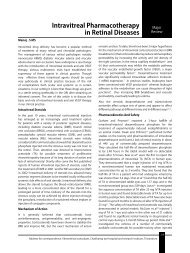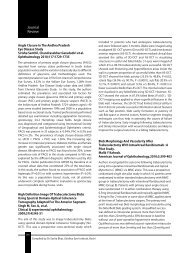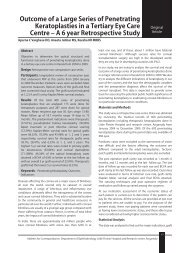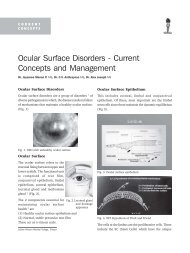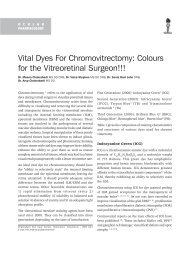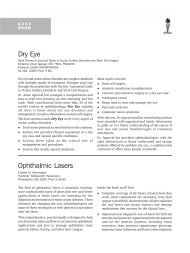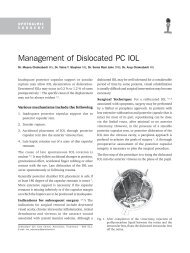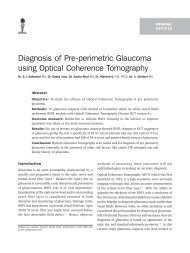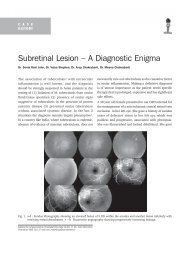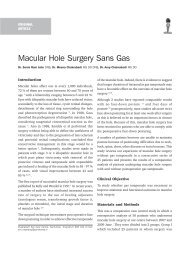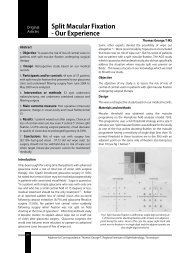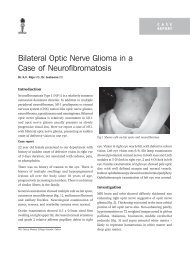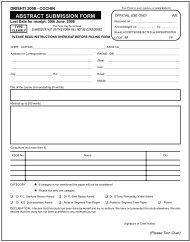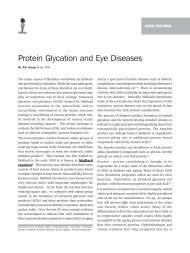Artificial Human vision - KSOS
Artificial Human vision - KSOS
Artificial Human vision - KSOS
You also want an ePaper? Increase the reach of your titles
YUMPU automatically turns print PDFs into web optimized ePapers that Google loves.
428 Kerala Journal of Ophthalmology Vol. XXI, No. 4<br />
stimulator based on multiple microchips have been tried<br />
on animal experiments, another Japanese project based<br />
on supra choroidal –trans retinal stimulation, the<br />
minimal invasive retinal project of Prof Heinrich<br />
Gerding in Switzerland, the Seoul <strong>Artificial</strong> project of<br />
Prof Hum Chung etc.<br />
Conclusion<br />
With ongoing advances in technology, surgical<br />
techniques and treatment options, there has been<br />
significant advancement towards restoring some <strong>vision</strong><br />
to patients suffering from RP.<br />
Although many advances have been made, the field of<br />
artificial <strong>vision</strong> is still young.We hope within another<br />
five years, patients with retinitis pigmentosa will be<br />
able to receive a retinal prosthesis, suitable to their<br />
needs, and possess <strong>vision</strong> allowing them to possibly<br />
perform. The management options of AMD has changed<br />
a lot since the retinal prosthesis started developing in<br />
nineties. In the dawn of anti VEGF era, the number of<br />
patients who needs prosthetic <strong>vision</strong> due to this disease<br />
is expected to fall according to many researchers.<br />
Future research by all AHV groups will need to address<br />
more on the energy needs, its supply, long-term<br />
biocompatibility of microelectronics in the saline<br />
environment of the eye in terms of hermetic packaging<br />
of the micro fabricated electrode arrays, minimization<br />
of the heat generated and dissipated with its use, effect<br />
of chronic electrical stimulation on the retina etc. In<br />
addition to this, significant attention needs to be given<br />
to the manner in which visual images will be encoded<br />
and delivered in patterns of electrical stimulation to<br />
the retina. Plasticity of the visual system in response to<br />
electrical stimulation as well as how the brain interprets<br />
a pattern of stimulation resulting from thousands of,<br />
electrodes has to be understood well and will be crucial<br />
in the evolution of better prosthetic design.<br />
We can thus tell our patients with outer retinal<br />
degenerations that there is progress toward an<br />
electronic retinal prosthesis but fully functional, longlasting<br />
devices are not on the immediate horizon.<br />
References<br />
1. Cornsweet TN. The retinal prosthesis is based on the<br />
fundamental concept of replacing photoreceptor<br />
function with an electronic device. Visual Perception.<br />
Academic Press, NY, USA (1970).<br />
2. Santos A, Humayun MS, de Juan E, Jr., Greenburg RJ,<br />
Marsh MJ, Klock IB, Milam AH (1997) Preservation of<br />
the inner retina in retinitis pigmentosa. A morphometric<br />
analysis. Arch Ophthalmol 115:511–515. 344 Sekirnjak<br />
et al.<br />
3. Humayun MS, Prince M, de Juan E, Jr., Barron Y,<br />
Moskowitz M, Klock IB, Milam AH (1999)<br />
Morphometric analysis of the extramacular retina from<br />
postmortem eyes with retinitis pigmentosa. Invest<br />
Ophthalmol Vis Sci 40:143–148<br />
4. Arturo Santos, MD; Mark S. Humayun, MD, PhD; Eugene<br />
de Juan, Jr, MD; Robert J. Greenburg; Marta J. Marsh,<br />
MS; Ingrid B. Klock; Ann H. Milam, PhD. Arch<br />
Ophthalmol. 1997;115(4):511-515.<br />
5. Dagnelie G. Toward an artificial eye. IEEE Spectrum<br />
22–29 (1996).<br />
6. Normann RA, Maynard EM, Guillory KS, Warren DJ.<br />
Cortical implants for the blind. IEEE Spectrum 33, 54–<br />
59 (1996).<br />
7. Hambercht FT. The history of neural stimulation and<br />
its relevance to future neural prostheses. In: Neural<br />
Prostheses: Fundamental Studies. Agnew WF, McCreery<br />
DB (Eds). Prentice Hall, NJ, USA (1990).<br />
8. Brindley GS, Lewin WS. The sensations produced by<br />
electrical stimulation of the visual cortex. J. Physiol.<br />
196, 479–493 (1968)<br />
9. Dobelle W. <strong>Artificial</strong> <strong>vision</strong> for the blind by connecting<br />
a tele<strong>vision</strong> camera to the brain. ASAIO J. 46, 3–9<br />
(2000).<br />
10. Maynard EM, Nordhausen CT, Normann RA. The Utah<br />
intracortical electrode array: a recording structure for<br />
potential brain- computer interfaces Electroencephalogr.<br />
Clin. Neurophysiol. 102, 228–239 (1997)<br />
11. Naik G, Regalado A. An inventor struggles to restore<br />
sight. In: Wall Street Journal, NY, USA, B1 (2003)<br />
12. Xinyu chai, Liming li, Kaijie wu, Chuanqing zhou,<br />
Pengjia cao, and Qiushi Ren IEEE Engineering in<br />
medicine and biology magazine<br />
13. Weiland JD, Liu W, Humayun MS. Retinal prosthesis.<br />
Annu Rev Biomed Eng 2004.<br />
14. Humayun MS, de Juan E Jr, Dagnelie G, Greenberg RJ,<br />
Propst RH, Phillips DH. Visual perception elicited by<br />
electrical stimulation of retina in blind humans. Arch<br />
Ophthalmol 1996;114:40-6.<br />
15. Humayun MS, de Juan E Jr, Weiland JD, Dagnelie G,<br />
Katona S, Greenberg R. Pattern electrical stimulation<br />
of the human retina. Vision Res 1999;39:2569-76.<br />
16. Humayun MS, Weiland JD, Fujii GY, Greenberg R,<br />
Williamson R, Little J, et al. Visual perception in a blind<br />
subject with a chronic microelectronic retinal prosthesis.<br />
Vision Res 2003;43:2573-81.<br />
17. Feasibility Study of a Retinal Prosthesis: Spatial Vision<br />
With a 16-Electrode Implant A Caspi, JD Dorn, KH<br />
McClure, MS Humayun … - Archives of Ophthalmology,<br />
2009 - Am Med Assoc



